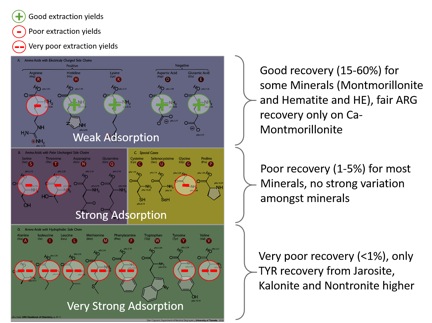2015 Annual Science Report
 University of Wisconsin
Reporting | JAN 2015 – DEC 2015
University of Wisconsin
Reporting | JAN 2015 – DEC 2015
Project 1B: Recovery of Mineral-Associated Amino Acids
Project Summary
As the single most abundant molecules in a cell (apart from water), amino acids are among the most widespread biomolecules on Earth. Amino acids are the building blocks of proteins and are also used for countless other functions, such as signal transduction, in all domains of life. Of special interest are the α-amino acids that have both the amine and carboxylic acid group attached to the first carbon (α) atom and have an organic substituent as the functional side chain. These amino acids include the 23 proteomic amino acids which are linked together by protein translating machinery into peptides resulting in the formation of proteins. Many amino acids display isomerism resulting in the appearance of L- and D- amino acids. Amino acids have been detected in numerous extreme environments as well as in extraterrestrial meteorites. But they are fragile and can be rapidly degraded when exposed to UV radiation and other oxidizing conditions. The differences in side chains between the amino acids have an effect on their charge and polarity. The resulting differences between amino acids makes their interaction with minerals variable. This may result in different extraction rates when recovering them from soils. On the other hand, the structural molecular resemblance of amino acids makes them hard to separate and detect individually by techniques such as HPLC or LCMS. Derivatization methods have been produced to optimize separation and thus detection. Due to their high occurrence on Earth (and in specific space environments) and their role in biological processes, amino acids are good molecular biomarkers. The aim of this study was to determine the extraction efficiency of amino acids from a range of minerals that are found on Mars.
Project Progress
It is important to investigate the preferences of different amino acids for adsorption to specific minerals. We have tested the extraction properties of 17 amino acids and 8 minerals.

The adsorption properties and characteristics of clays and other minerals with relevance to Mars research were determined via a hot-water extraction procedure of amino acids and subsequent chromatographic identification and mass-detection. The minerals from Table 1 were ground (2 µm grain size) and spiked with a 100 µM L-amino acid standard containing the amino acids listed in Table 2. The minerals plus spiking solution was agitated gently for 24 hours before being centrifuged and the supernatant, which contained unbound amino acids, was removed. Ultra-pure water was added to the minerals followed by vortexing in order to remove loosely bound amino acids. This step was repeated two times (see Figure 1) before commencing the actual hot-water extraction, where tubes containing minerals and ultra-pure water were sealed and heated to 100 °C for 24 hours. After centrifugation of the minerals, the supernatant solution was collected, further purified by passing through an activated resin exchange column before being analyzed with and HPLC-FLD and LC-MS (ion trap) system.

Preliminary analysis of the acquired dataset allowed to calculate extraction yields of the spiked amino acids and gave clues in order to correlate amino acid and mineral properties with the extend of adsorption/desorption. A general trend that could be observed is that physical and chemical composition and properties of for example clay minerals, e.g. Calcium rich versus Aluminium pillared Montmorillonite clay, can strongly affect the extraction efficiency. Furthermore the polarity of the amino acid side chains are mainly responsible for an effective extraction from the selected minerals (see Figure 2). Positively or negatively charged amino acids generally show relatively good extraction yields. Amino acids with polar uncharged or hydrophobic side chains show poor levels of recovery.
Nevertheless, our preliminary results clearly show that mineral adsorption and amino acid recovery can vary significantly depending on physical and chemical properties of the minerals. It is therefore important to study in detail and individually the interaction of an amino acid-mineral pair.

Preliminary conclusion:
* The swelling clay-rich smectite minerals show the most intriguing adsorption properties. CN-analysis, TGA and HPLC/FD all indicate these clays as ‘special’ * Although clays are known to hinder extraction by adsorption, our results indicate relatively high extraction yields for the clays for some amino acids * Presence of specific ions (Al, Ca) changes adsorption behavior of Montmorillonite * Differences in recovery/adsorption appear to result from both amino acid side chain as well as from mineral properties
References:
Aerts, J. W., Röling, W. F. M., Elsaesser, A. & Ehrenfreund, P. Biota and biomolecules in extreme environments on Earth: implications for life detection on Mars. Life 4, 535–65 (2014).
Publications
-
Aerts, J., Röling, W., Elsaesser, A., & Ehrenfreund, P. (2014). Biota and Biomolecules in Extreme Environments on Earth: Implications for Life Detection on Mars. Life, 4(4), 535–565. doi:10.3390/life4040535
-
Cottin, H., Kotler, J. M., Bartik, K., Cleaves, H. J., Cockell, C. S., De Vera, J-P., … Westall, F. (2015). Astrobiology and the Possibility of Life on Earth and Elsewhere…. Space Science Reviews. doi:10.1007/s11214-015-0196-1
-
Röling, W. F. M., Aerts, J. W., Patty, C. H. L., Ten Kate, I. L., Ehrenfreund, P., & Direito, S. O. L. (2015). The Significance of Microbe-Mineral-Biomarker Interactions in the Detection of Life on Mars and Beyond. Astrobiology, 15(6), 492–507. doi:10.1089/ast.2014.1276
-
PROJECT INVESTIGATORS:
-
PROJECT MEMBERS:
Joost Aerts
Collaborator
Andreas Elsässer
Collaborator
-
RELATED OBJECTIVES:
